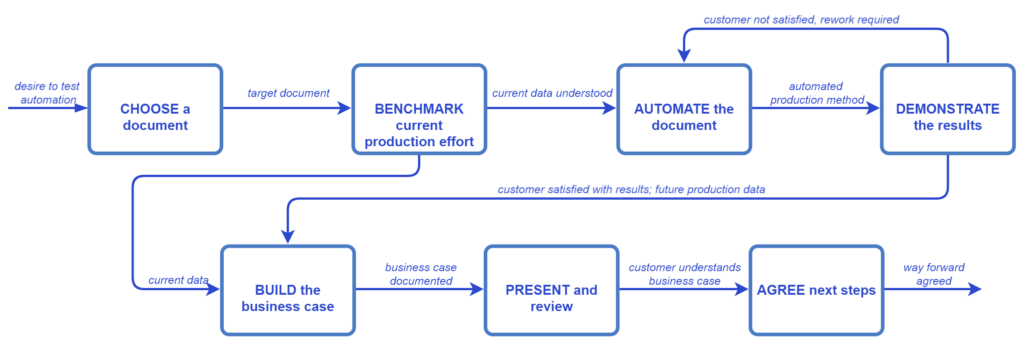Running a document automation proof-of-concept
What is a proof-of-concept?
A proof-of-concept (POC) of document automation is typically run to test whether there is a business case for the technology in the law firm or legal department. It is a low-cost way of establishing that case. Typically, we automate a single document to allow a prospective client to see what the resulting output looks like (how good it looks, how complete it is), and to see what the economics of automation might look like. Usually, we find that the document can be produced with much less effort (and certainly with a reduced revision cycle time), and to a higher quality, resulting in less rework after client review. The business case looks at how quickly the investment of time and money in automation can be recovered through the lower post-automation production cost.
What does a proof of concept comprise?

CHOOSE
We typically run proofs-of-concept POCs with between one and three documents. Often one is enough to demonstrate the power and efficiency of this technology. The first document should be one that has a widely-used template currently, that is one of the more commonly produced documents, and that has well-understood rules around its production. Too simple a document – the business case will be unconvincing; too complex – the POC will take too long, and too much customer time to resolve production rules.
BENCHMARK
We will collect all the data around the document’s current production:
- volumes, by month/year;
- peaks and troughs in volumes, and reasons for them;
- effort to produce an “average” version of the document, by grade;
- effort on “easy” and “hard” versions of the document, by grade;
- analysis of the causes of variation in effort;
- unit hourly costs (not charge-out rates), by grade.
AUTOMATE
We will develop:
- a model of all the data in the document, to ensure we understand it properly;
- a marked-up version of a template of the document;
- a script for an interview to allow the lawyer to feed the correct data for a specific matter.
We will run and test the interview to ensure the right data is in the right place in the document.
Throughout this stage we will be measuring our own effort on the different elements of the automation process.
DEMONSTRATE
We will demonstrate the interview process to the lawyer, to obtain feedback. We will make revisions as necessary. We will also collate all the data about both the investment effort, and the future production costs post-automation.
BUILD
We will build and document the business case.
PRESENT
We will present the business case to the POC’s commissioner, and other interested parties.
AGREE
We will agree next steps with the customer – this might be an extension of the POC to one further document. We might just shake hands and go our separate ways, for now or for good, though this is unlikely. Or you might request a proposal from us for a full automation project. We’re ready and willing.
What will the business case tell me?

The business case calculates the pre- and post-automation production costs, based on the effort of each grade of lawyer (and other personnel) to produce the document, and their unit (hourly) costs. The business case then calculates the total production costs, based on the anticipated monthly volumes, as well as the one-off investment (development) costs. We calculate a simple cash-flow, to see when these development costs are recouped – in this case (a very small implementation) we can see it is by the end of month 4….
What will it take to do, and how do I get started?
You will need to invest a few hours of lawyer time to help our developers understand the document and review the outputs from the automation.
You will need to invest some of your time to review the POC and what it tells you about the potential for document automation to make a big difference to your business.
All you need to do is to call us on 07793 166787 or email enquiries@anaxas.co.uk. We look forward to hearing from you.
NOTICES
CONTACT US
- Get in touch
- 07793 166787
- enquiries@anaxas.co.uk
© 2020 Anaxas Business Services Ltd